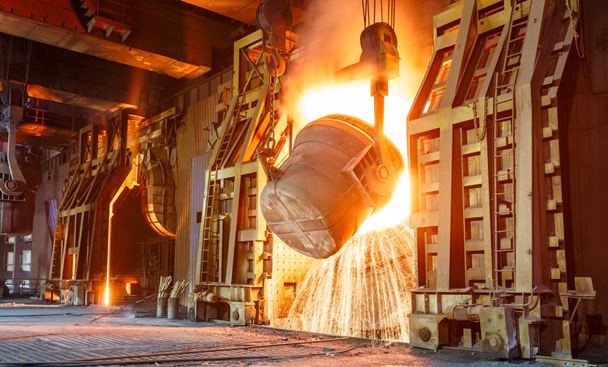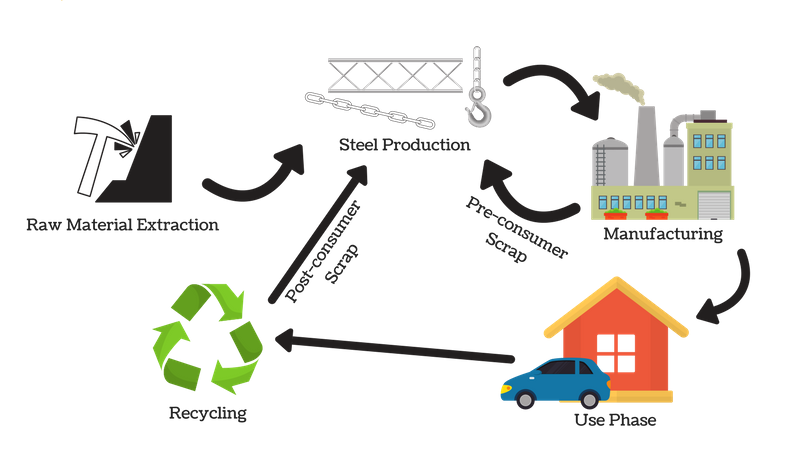Steel production & environmental impact
Manufacture of Steel
Today, steel making comes from both recycled as well as raw materials. Two processes:
- Basic Oxygen Steelmaking (BOS)/ Basic Oxygen Furnace (BOF) and
- Electric Arc Furnace (EAF) accounts for virtually all steel production.
Primary steel production: Primary steelmaking methods differ between BOS and EAF methods.
BOS methods add recycled scrap steel to the molten iron in a converter. At high temperatures, oxygen is blown through the metal, lowering silicon, manganese and phosphorous levels and lowering carbon content to between 0-1.5%. The addition of chemical cleaning agents called fluxes helps to reduce the sulfur and phosphorous levels.
EAF methods, alternatively, derived from 90 -100% recycled steel scrap and passed high-power electric arcs (temperatures up to 1650 °C) to melt the metal and convert it to high-quality steel.

Secondary steel production: Secondary steelmaking involves treating the molten steel produced from both BOS and EAF routes to adjust the steel composition. This is done by adding or removing certain elements and/or manipulating the temperature and production environment.
Continuous Casting
The molten steel is cast into a cooled mold causing a thin steel shell to solidify. The shell strand is withdrawn using guided rolls and fully cooled and solidified. The strand is cut into desired lengths depending on the application; slabs for flat products (plate and strip), blooms for sections (beams), billets for long products (wires), or thin strips.
Primary Forming
The steel that is cast is then formed into various shapes, often by hot rolling, a process that eliminates cast defects and achieves the required shape and surface quality. Hot rolled products are divided into flat products, long products, seamless tubes, and specialty products.
Manufacturing, Fabrication and Finishing
Finally, secondary forming techniques give the steel its final shape and properties. These techniques include:
- shaping (e.g. cold rolling)
- machining (e.g. drilling)
- joining (e.g. welding)
- coating (e.g. galvanizing)
- heat treatment (e.g. tempering)
- surface treatment (e.g. carburizing)

The environmental impact of steel production
Steel production has a number of impacts on the environment, including air emissions (CO, SOx, NOx, PM2), wastewater contaminants, hazardous wastes, and solid wastes. The major environmental impacts from integrated steel mills are from coking and iron-making.

| ENVIRONMENTAL IMPACT | MANUFACTURER INFORMATION / COMMENTS: |
Climate change |
Virtually all of the greenhouse gas emissions associated with steel production are from the carbon dioxide emissions related to energy consumption. |
| Emissions to air | Coke production is one of the major pollution sources from steel production. Air emissions such as coke oven gas, naphthalene, ammonium compounds, crude light oil, sulfur and coke dust are released from coke ovens. |
| Emissions to water | Water emissions come from the water used to cool coke after it has finished baking. Quenching water becomes contaminated with coke breezes and other compounds. While the volume of contaminated water can be great, quenching water is fairly easy to reuse. Most pollutants can be removed by filtration. |
| Waste | Slag, the limestone and iron ore impurities collected at the top of the molten iron, make up the largest portion of iron-making by-products. Sulfur dioxide and hydrogen sulfide are volatized and captured in air emissions control equipment and the residual slag is sold to the construction industry. While this is not a pollution prevention technique, solid waste does not reach landfills. Gaseous emissions and metal dust are the most prominent sources of waste from electric arc furnaces. |
Sourced: Internet
OUR FABRICATION PROCESS
If you want reliable steel parts, contact the experts at AM Industries Vietnam. Our processes include stamping, welding, folding, bending, and finishing to match our exact requirements.
Working as a solution provider, at AM Industries Vietnam, we are completely focused on our approach and it is reflected in our business process. Due to our committed approach, we are highly trusted by our clients.
It has further helped us to achieve a respectful position among our competitors. AM’s a dynamic company and it is conquering big markets through its two primary strategies: Total quality & Flexibility.
We believe in an industrial world made of trust, passionate and dedicated people. We word to achieve this with an open-minded, quick and customer-centered approach.
Want to learn more about our steel fabrication services in Vietnam? Contact us today for a quote based on your requirements. If you need help, our experienced engineers are available to help determine the requirements for your specific project.
Please feel free to get in touch with us for all your inquiries.


